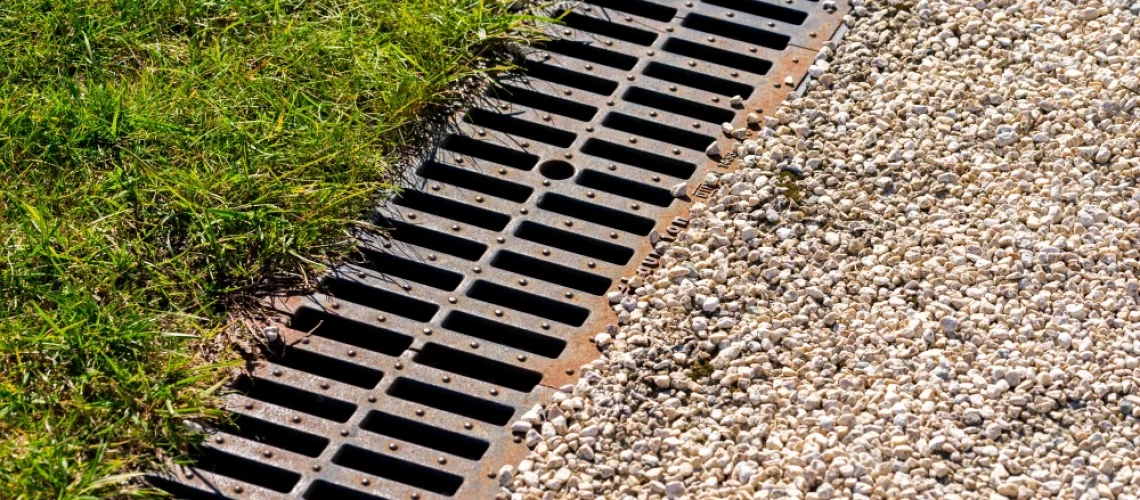The Canadian province of Ontario is very prone to heavy rainfall and flooding. It is a province where people wait anxiously to see the sun in its sunny weather. Heavy rain is a very common phenomenon, which raises another critical issue: drain clogging.
Water problems are a common frustration for homeowners across Ontario, thanks to our lovely clay soil and dramatic freezing temperatures. A French drain is often recommended as the solution, and when done right, it can be incredibly effective. But here’s the catch: a poorly installed French drain isn’t just ineffective; it can be a costly mistake that increases your problem instead of solving it.
What Exactly Is a French Drain? It’s Not Actually French!
You might be surprised to know that French Drain isn’t actually French in origin, just like the famous French fries that Canadians love are actually Belgian in origin. The French part actually comes from the name of its ideator, Henry Flagg French, a 19th-century American farmer, lawyer, and Assistant U.S. Treasury Secretary, who popularized the concept in his 1859 book, “Farm Drainage.” The concept came from the exact book in which he wrote about and popularized the concept of using trenches filled with gravel or rock to redirect surface water and groundwater away from an area.
The idea was simple yet highly effective: collect water by carving an easy path for it. It was so effective that it instantly made its way into farms and soon into cities. It is still considered one of the best draining methods and is highly popular around the world.
What a French Drain Comprises of
The idea of the French drain is simple and uses just a few essentials to complete it. It is not a task that requires manpower since even one person can do it and might need slight help from another person. It comprises of the following:
Trench – The Foundation
A trench is dug around the area needing drainage (like the perimeter of your foundation or across a soggy part of the yard). This trench needs to have a specific, gentle slope.
Pipe – The Channel
A perforated pipe (a pipe with small holes or slits) is laid in the bottom of the trench.
Gravel – The Drain Path Maker
The pipe is surrounded by clean gravel or crushed stone. This allows water to easily filter through.
Fabric – A Proactive Protection
Often, a special filter fabric lines the trench and surrounds the gravel. This is crucial – it prevents silt and soil from clogging the pipe and gravel over time.
Outlet – The Water Collection System
The pipe carries the collected water away from the problem area to a suitable discharge point (like a storm sewer, a dry well, or simply downhill away from structures).
When water enters the trench, it filters through the gravel, enters the pipe through the perforations, and flows away thanks to gravity and the slope of the pipe.
French Drain – It Is Simple But Requires Expertise
What might seem easy isn’t necessarily always easy. This applies to the French drain system because there are certain components that need to be handled with care. DIYing it can be costly, as it raises the following problems:
- Wrong Depth/Slope: This part is the system’s foundation and need to be done properly, because if the foundation is not right, the whole system is not right. You need to dig properly below the frost line with slope for it to work properly, or the water won’t fully flow.
- Ignoring Filter Fabric: Skipping the filter fabric is a common DIY mistake that might work for the moment but will be costly in the future. Without one, the silt and soil will eventually clog the gravel and pipe, making the entire system useless.
- Incorrect Gravel: the size also needs to be correct. Using the wrong type or size of gravel can also lead to clogging or poor drainage.
- Improper Discharge: Dumping the water in the wrong spot can just move the problem elsewhere or even cause issues for your neighbours. You don’t want to fight with them, so discharge the water into the proper channel.
Ideal Characteristics of a French Drain That Works – What Pros Get Right
We all know there is always a difference in what we do versus what pros do. There work is sophisticated and they do it in the exact way it is supposed to be done. But what exactly do they do right that makes them different from us or any unprofessional contractor?
Here is a list of what they do right:
- Thorough site assessment
- Correct trenching with depth and slope
- High-end materials
- Strategic water discharge
- Careful backfilling and restoration
Good Detective Work – Thorough Site Assessment
A good contractor won’t just start digging. They’ll assess your specific water problem, analyze the slope of your property, identify the soil type, and determine the best location and discharge point for the drain.
No Lose Hands – Correct Trenching With Depth And Slope
The trench will be dug to the appropriate depth, considering the frost line and foundation footings. It should be properly graded with the correct slope to ensure positive water flow via gravity.
No Compromise on Quality – High-End Materials
Professionals use durable, high-quality perforated pipes, clean drainage gravel of the correct size, and robust filter fabric designed to prevent clogging while allowing water passage.
Professional Work And Techniques – Strategic Water Discharge
The collected water needs to go somewhere safe and appropriate. A professional will ensure that they discharge the water far away from foundation walls, often connecting to a storm sewer, installing a dry well, or using a pop-up emitter in a suitable location.
Protective Work – Careful Backfilling & Restoration
Once the system is installed, the trench needs to be backfilled carefully to protect the pipe and ensure proper function.
The Major War – How To Find the Right French Drain Installer in Ontario
Not just the techniques and materials, but there are certain characteristics these professional contractors have. These are:
- Good experience
- References and reviews
- Licensing and insurances
- Detailed written quote
Dealing with Drainage Issues in Ontario? Call The Experts at TruBuild Contracting Now!
Are you having struggles with a wet basement or a soggy yard? Contacting the right contractor will solve your problem, and TruBuild Contracting is that. We have extensive experience solving drainage challenges for homeowners across Ontario. We have provided our services in Ontario for more than two decades, and we are known to satisfy our customers.
What are you waiting for? Get your cloggy French drain fixed by visiting our website at https://trubuildcontracting.ca/ or give us a call at (613) 438-8570!

